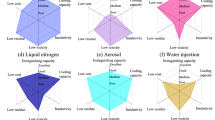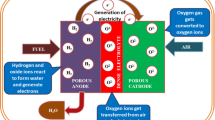Abstract
Thermogravimetry and differential scanning calorimetry (DSC) were used to investigate the thermal stability of four nitrate-based ionic liquids. The variations of thermal behavior for different numbers or lengths of alkyl substituents for imidazolium cations were analyzed systematically. Long-term stability and operating temperature for 1.0% mass loss during 10 h (T0.01, 10 h) were estimated using model-free perdition methodologies. The results of T0.01, 10 h were predicted to be 78.73 and 81.59 °C for [Bim][NO3] and [Mim][NO3], respectively. The apparent activation energy (Ea) was obtained using four isoconversional methods at various heating rates through DSC experiments. This study confirmed that [Bim][NO3] and [Mim][NO3] decomposed swiftly, and the gaseous products can result in ignition and continuous combustion.









Similar content being viewed by others
Abbreviations
- A(α):
-
Pre-exponential factor (s−1)
- \(\alpha\) :
-
Degree of conversion (dimensionless)
- \(\beta\) :
-
Heating rate (°C min−1)
- E a :
-
Apparent activation energy (kJ mol−1)
- f(α):
-
Most probable kinetic function (dimensionless)
- \(\it {\text{G}}\left( \alpha \right)\) :
-
Integral mechanism function (dimensionless)
- ΔH d, avg :
-
Average heat of decomposition (J g−1)
- R :
-
Universal gas constant (8.31415 J K−1 mol−1)
- T :
-
Temperature (°C)
- T 0.01, 10 h :
-
Temperature at mass loss reaches 1.0% for 10 h (°C)
- t :
-
Time (min)
References
Lei Z, Chen B, Koo YM. Introduction: ionic liquids. Chem Rev. 2017;117:6633–5.
Rogers RD, Seddon KR. Ionic liquids–solvents of the future? Science. 2003;302:792–3.
Maton C, Vos ND, Stevens CV. Ionic liquid thermal stabilities: decomposition mechanisms and analysis tools. Chem Soc Rev. 2013;42:5963–77.
Chen X, Ma C, Jiao C. Synergistic effects between [Emim]PF6 and aluminum hypophosphite on flame retardant thermoplastic polyurethane. RSC Adv. 2016;6:67409–17.
Jiao C, Wang H, Li S, Chen X. Fire hazard reduction of hollow glass microspheres in thermoplastic polyurethane composites. J Hazard Mater. 2017;332:176–84.
Kamavaram V, Reddy RG. Thermal stabilities of di-alkylimidazolium chloride ionic liquids. Int J Therm Sci. 2008;47:773–7.
Wang R, Jin CM, Twamley B, Shreeve JM. Syntheses and characterization of unsymmetric dicationic salts incorporating imidazolium and triazolium functionalities. Inorg Chem. 2006;45:6396–403.
Xiao JC, Shreeve JM. Synthesis of 2, 2′-biimidazolium-based ionic liquids: use as a new reaction medium and ligand for palladium-catalyzed Suzuki cross-coupling reactions. J Org Chem. 2005;70:3072–8.
Swatloski RP, Spear SK, Holbrey JD, Rogers RD. Dissolution of cellose with ionic liquids. J Am Chem Soc. 2002;124:4974–5.
Tao F, Song H, Chou L. Catalytic conversion of cellulose to chemicals in ionic liquid. Carbohydr Res. 2011;346:58–63.
Latip NAA, Ng HM, Farah N, Ramesh K, Ramesh S. Novel development towards preparation of highly efficient ionic liquid based co-polymer electrolytes and its application in dye-sensitized solar cells. Org Electron. 2017;41:33–41.
Lin HH, Peng JD, Suryanarayanan V, Velayutham D, Ho KC. Perfluoro anion based binary and ternary ionic liquids as electrolytes for dye-sensitized solar cells. J Power Sources. 2016;311:167–74.
Zhang Y, Gao H, Joo YH, Shreeve JNM. Ionic liquids as hypergolic fuels. Angew Chem Int Ed. 2011;50:9554–62.
Earle MJ, Esperanca JMSS, Gilea MA, Lopes JNC, Rebelo LPN, Magee JW, Seddon KR, Widegren JA. Lithium-ion batteries: advanced materials and technologies. Nature. 2006;439:831–4.
Liaw HJ, Huang SK, Chen HY, Liu SN. Reason for ionic liquids to be combustible. Procedia Eng. 2012;45:502–6.
Cao Y, Mu T. Comprehensive investigation on the thermal stability of 66 ionic liquids by thermogravimetric analysis. Ind Eng Chem Res. 2014;53:8651–64.
Katritzky AR, Singh S, Kirichenko K, Smiglak M, Holbrey JD, Reichert WM, Spear SK, Rogers RD. In search of ionic liquids incorporating azolate anions. Chem Eur J. 2006;17:4630–41.
Wellens S, Thijs B, Binnemans K. How safe are protic ionic liquids? Explosion of pyrrolidinium nitrate. Green Chem. 2013;15:3484–5.
Smiglak M, Reichert WM, Holbrey JD, Wilkes JS, Sun L, Thrasher JS, Kirichenko K, Singh S, Katritzky AR, Rogers RD. Combustible ionic liquids by design: is laboratory safety another ionic liquid myth? Chem Commun. 2006;24:2554–6.
Gelfand BE, Khomik SV, Eremenko LT, Tsiganov SA. Basic features of the self-ignition of atomized liquid nitro/nitrate/nitrite compounds in a gaseous medium. Proc Combust Inst. 2000;28:879–83.
Hainer RM. The application of kinetics to the hazardous behavior of ammonium nitrate. Symp Int Combust. 1955;5:224–30.
Olivares RI. The thermal stability of molten nitrite/nitrates salt for solar thermal energy storage in different atmospheres. Sol Energy. 2012;86:2576–83.
Wang C, Du Y, Che D. Study on N2O reduction with synthetic coal char and high concentration CO during oxy-fuel combustion. Proc Combust Inst. 2015;35:2323–30.
Classification, Labelling and Packaging (CLP) of Substances and Mixtures, European Chemicals Agency, Helsinki. ISBN: 978–92–9247–413–3.
Grigiante M, Brighenti M, Antolini D. Analysis of the impact of TG data sets on activation energy (E a). J Therm Anal Calorim. 2017:129:553–65.
Quraishi KS, Bustam MA, Krishnan S, Khan MI, Wilfred CD, Lévêque JM. Thermokinetics of alkyl methylpyrrolidinium [NTf2] ionic liquids. J Therm Anal Calorim. 2017;129:261–70.
Sinapour H, Damiri S, Pouretedal HR. The study of RDX impurity and wax effects on the thermal decomposition kinetics of HMX explosive using DSC/TG and accelerated aging methods. J Therm Anal Calorim. 2017;129:271–9.
ASTM D 93, Standard test methods for flash-point by Pensky-Martens closed cup tester, American Society for Testing and Materials, West Conshohocken, PA, USA (2016).
Geyer A, Alicke B, Konrad S, Schmitz T, Stutz J, Platt U. Chemistry and oxidation capacity of the nitrate radical in the continental boundary layer near Berlin. J Geophys Res-Atmos. 2001;106:8013–25.
Smiglak M, Hines CC, Reichert WM, Vincek AS, Katritzky AR, Thrasher JS, Sun L, McCrary PD, Beasley PA, Kelley SP, Rogers RD. Synthesis, limitations, and thermal properties of energetically-substituted, protonated imidazolium picrate and nitrate salts and further comparison with their methylated analogs. New J Chem. 2012;36:702–22.
Acknowledgements
The authors are indebted to the Ministry of Science and Technology (MOST) in Taiwan under the Contract Number 104-2622-E-224-009-CC2 for financial support, as well as the Department of Natural Sciences Key Fund, Bureau of Education, Anhui Province, China, for its financial support under Contract Number KJ2017A078.
Author information
Authors and Affiliations
Corresponding author
Rights and permissions
About this article
Cite this article
Lin, WC., Yu, WL., Liu, SH. et al. Thermal hazard analysis and combustion characteristics of four imidazolium nitrate ionic liquids. J Therm Anal Calorim 133, 683–693 (2018). https://doi.org/10.1007/s10973-018-7319-3
Received:
Accepted:
Published:
Issue Date:
DOI: https://doi.org/10.1007/s10973-018-7319-3




